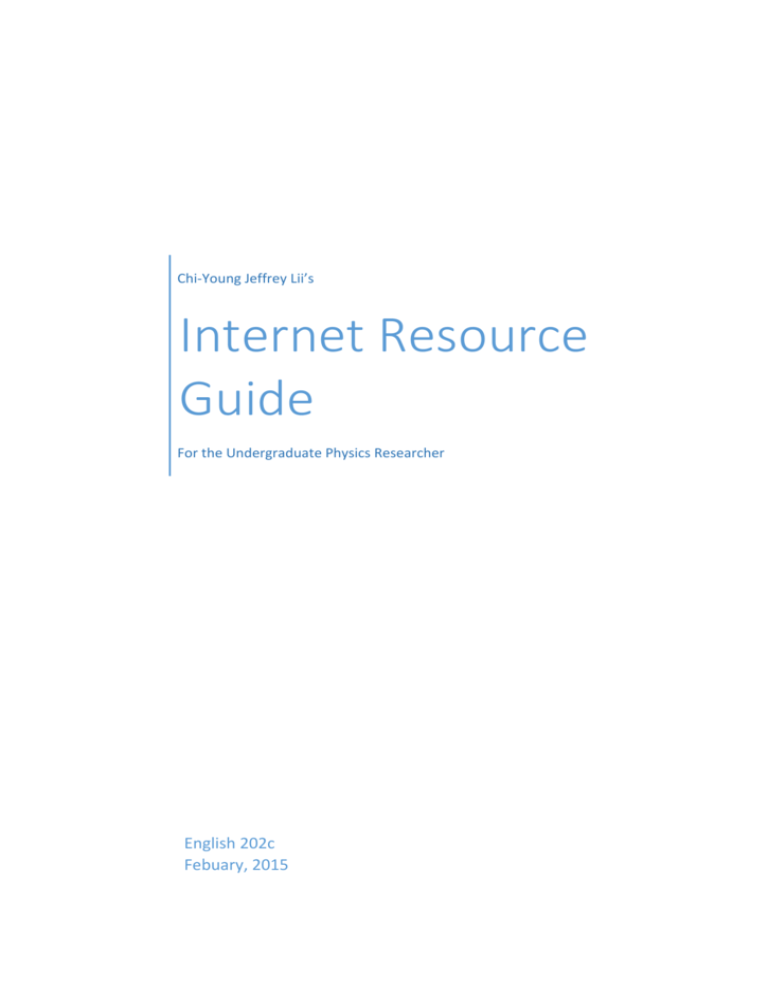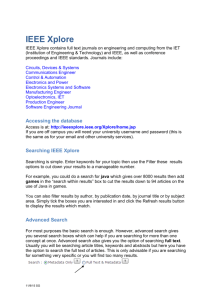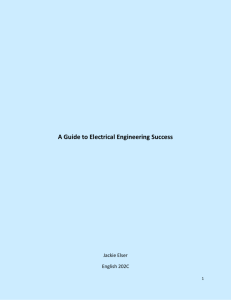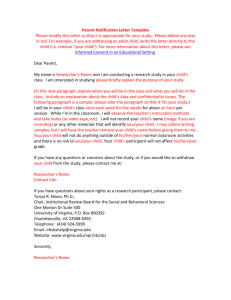Internet Resource Guide - Sites at Penn State
advertisement

Chi-Young Jeffrey Lii’s Internet Resource Guide For the Undergraduate Physics Researcher English 202c Febuary, 2015 Table of Contents Table of Contents ........................................................................................................... 1 Preface ........................................................................................................................... 2 Contents of the Guide ................................................................................................ 2 Audience of the Guide ............................................................................................... 2 Assumptions of the Guide.......................................................................................... 2 Organization of the Guide .......................................................................................... 2 Tips for using the Guide ............................................................................................. 3 Government Publications .............................................................................................. 4 Catalog of US Government publications .................................................................... 4 The 2012 Statistical Abstract of the United States .................................................... 4 US Patent and Trademark Office ................................................................................ 5 Useful Resources ............................................................................................................ 6 MIT Open Courseware ............................................................................................... 6 Physics Today.............................................................................................................. 6 American Journal of Physics....................................................................................... 7 Databases ....................................................................................................................... 8 IEEE Xplore ................................................................................................................. 8 IOP Science ................................................................................................................. 8 1 Preface Contents of the Guide The “Internet Resource Guide for the Undergraduate Physics Researcher” is a compendium of useful online resources for the first time Physics researcher. The guide contains a compendium of online websites, databases, and search engines to help common obstacles during the undergraduate student’s studies. For example: search engines to find scholarly articles, magazines and journals to keep up with current physics trends, and supplemental reading to shore up weak foundational skills. Audience of the Guide The intended readers of this guide are the inexperienced undergraduate physics researchers who need direction while embarking on their first research opportunity. It is not enough to have good mentorship and a strong educational background. An undergraduate physics researcher must also have a strong selection of tools to choose from to adapt to any situation and overcome any obstacle. Assumptions of the Guide Researchers should have a strong mathematical ability and how to use a Boolean search engine. They should also have strong physics foundation. Many of the resources, primarily the scholarly articles, will have a lot of technical writing; users should have experience with reading through mounds of abstracts and scholarly articles. Organization of the Guide The “Internet Resource Guide for the Undergraduate Physics Researcher” consists of a table of contents, a preface, and sections for government websites, useful research resources, and databases. The government publications sections will help the most when looking for information on government-funded research or patents. The useful resources section has links to MIT Open Courseware (a collection of foundational physics knowledge) and journals and magazines (for keeping up to date with current physics trends). The databases listed are mentioned to give the researcher a 2 good idea of where to look for specific scholarly articles. Tips for using the Guide 1. You aren’t expected to know everything. The most important thing to do when encountering a new term, concept, or method is to write it down and learn about it. Always learn something. 2. Building a strong foundation for future endeavors is important, but delivering a product is important too. Set goals for your research, and reach them. Communicate with your mentor to help meet them. 3 Government Publications Catalog of US Government publications Web Link: http://catalog.gpo.gov/F Abstract: The US Catalog of Government Publications is a government database for federal publications. Every government research paper (those that are public) will be on this website, meaning that if you are tasked to understand a government funded paper, you will most likely get that paper here. For example, let’s say you are reading a paper and see that another paper on superconductors is cited. If you wanted that paper, the first thing you should do is go to the US CGP and type in “superconductors”. This would bring up a list of relevant articles, one of which “Comparative assessment of direct drive high temperature superconducting generators in multi-megawatt class wind turbines [electronic resource]” is the one that you are looking for. You can see the author (“Maples, Ben”), see the publisher (“National Renewable Energy Laboratory [2010]”), and obtain a link to locate a library in which it might reside. The paper is an analysis of a new type of wind turbine with a superconductor, to an older model, which did not have a superconductor. The end conclusion was that the new model was competitive. Tips: 1. When looking for papers always try typing in the date of publication, the authors, and the subject of the study. 2. If you can’t find a patent in the US CGP you can also try the US PTO The 2012 Statistical Abstract of the United States Web Link: http://www.census.gov/compendia/statab/ Note: The statistical abstract was shut down in 2012. The information in the statistical abstract is out of date, and researchers looking to find current census data will need to look elsewhere for the most up to date information. Abstract. The US Statistical abstract is a long abstract of the US census, and it is also a 4 great place to find census data for the years before 2012. Although the Statistical Abstract was shut down in 2012, it is still online and still retains a great deal of useful information for the knowledgeable researcher. The Abstract is split into sections, with information such as “Banking, Finance, and Insurance” or “Energy and Utilities” as examples. An energy engineer would use the abstracts to gain a good idea of which areas consume the most power, and what the costs of building a new power plant in a general area is. The Population, Income, and Labor Force sections of the guide provide a useful picture of the US, and the Energy and Utility section may be extremely useful to any energy engineer. Tips: 1. You can download the 2012 Statistical Abstract as a pdf for offline usage. 2. If you need more up to date information you can go to the website of the US census, which is still operating and has plenty of information. US Patent and Trademark Office Web Link: http://patft.uspto.gov/ Abstract: The US PTO is a government database that contains all most US patent applications. When doing research for any purpose, physics researchers are often called upon to look over patents. There can be many versions of patents, and many are purposefully or unintentionally obfuscating. It is therefore useful to have a direct source for any patent. The US PTO online database maintains a full list of all US patents allowing physics researchers to download any patent that they might require. For example, if a paper a researcher is reading cites a patent, and he or she feels that she needs to read the patent, then he/she can go to the US PTO website and search for it. Tips: 1. Using the subject, date of publication, and author as the search words will yield the most accurate results 2. It’s possible to find the patent on google scholar if the patent cannot be found on the US PTO website. 5 Useful Resources MIT Open Courseware Web Link: http://ocw.mit.edu/courses/physics/ Abstract: MIT Open Courseware is a website full of online courses for physics subjects. It is difficult for a beginning researcher to have a complete grasp of all basic subjects, such as quantum mechanics, statistical mechanics, and thermodynamics, however, all these subjects are commonly touched upon by scholarly papers. Therefore it is convenient for a researcher to have a handy guide and resource for all these subjects, and the MIT Open Courseware is precisely that. A researcher may find a great deal of useful information on any basic physics subject if he or she so require. Tips: 1. Youtube.com has the MIT lectures online, looking at them may be better for visual learners. 2. Most of the courses are for undergraduates only, however there exists some graduate level courses including electromagnetic theory, quantum theory, and optical physic Physics Today Web Link: http://scitation.aip.org/content/aip/magazine/physicstoday Abstract: Physics Today is a well-known physics magazine that often publishes scholarly articles as well as easier to read articles. The topics Physics Today publishes are numerous, and range from things as esoteric as particle physics, to political articles such as one discussing the UK committee calling for a ban on fracking. Physics Today also has a convenient job posting board. The online magazine does ask for a membership, but log-in credentials are provided for free if you are entering the site from the Penn State network. Physics Today is a good read to keep up-to-date on the comings and goings of the physics field. Tips: 1. Don’t go to Physics Today for research papers, there are better databases. 6 Instead, take the time to read an article or two every day to expand your horizons. 2. Using the Most Read feature can give you an idea of what’s hot in the physics field right now. American Journal of Physics Web Link: http://scitation.aip.org/content/aapt/journal/ajp Abstract: The American Journal of Physics is a long standing publication in the history of scientific journals. It was started in 1933, and has continued to operate for over 80 years, and has set the standard for peer-reviews and quality information. The online site for the AJP is hosted by Scitation, the same as Physics today, but the AJP is more focused on scholarly physics information. The strong point of the AJP is that it is well known and has quality scholarly resources. It can be used safely as a physics database when looking for research materials. The weak point of the AJP is that it is very physics focus when compared to other online resources. Undergraduate researchers may need to use other resources when looking for less physics related information. Tips: 1. Like Physics Today, you should read it as a good way to keep up with the physics trends but unlike Physics today most of the articles are quality research articles. 2. The AJP is published by the American Association of Physics teachers. AAPT Website is full of information about events and competitions! Use this to your advantage! Participating in one or two of these events can be a great resume builder. 7 Databases IEEE Xplore Website: http://ieeexplore.ieee.org.ezaccess.libraries.psu.edu/Xplore/home.jsp Abstract: The Institute of Electrical and Electronic Engineering is an international organization that regularly publishes papers pertaining to Electrical Engineering. IEEE Xplore is their database. However, the IEEE also publish papers on many adjacent fields, including physics, chemistry, and material science. This flexibility makes IEEE Xplore a great database to use when you need information on techniques that aren’t very physics oriented. For example, an intern researcher might need information on gait algorithms for a robot they are programming. The IEEE Xplore would have papers on that. The IEEE Xplore does require a membership, but the Penn State University login will pay that for you. Tips: 1. IEEE Xplore forwards you an abstract on-site before you have to download the paper. This allows you to read the abstract and decide whether a paper is worth reading before downloading it. 2. Use the sidebar! In addition to date, subject, journal, and authors, you can search for custom keywords on the sidebar. It is a powerful tool that many other sites don’t have. IOP Science Website: http://iopscience.iop.org.ezaccess.libraries.psu.edu/journals The Institute of Physics (IOP) is a British research organization that has been around for a century and a half now. As a result, they are well known, and have a great deal of very technical scholarly articles. They also maintain an online database. This is basically the go-to database when you need information on physics subjects. In addition to staying on the cutting edge and regularly publishing new articles on current events and ground-breaking studies, the IOP also has a record of articles that reaches back fifty years. They are well known and mentors should have little or no problem accepting research from their databases. 8 Tips: 1. IOP is purely a physics website. The more physics oriented your search terms are the better results you will get. Knowing how to use a Boolean search engine will be very helpful here. 2. The IOP search engine lets you filter by PAC, date, subject, journal, and authors. Just click on the “Journals” tab. 9








